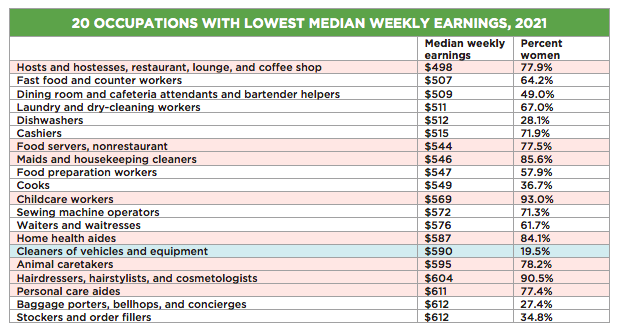
March 15 was Equal Pay Day: the day in which U.S. women finally reach, on average, the same amount of annual wages as men had gained during the previous year. This year’s Equal Pay Day is also a reminder of how women, especially women of color, have faced numerous setbacks during the global pandemic.
In a new report, the U.S. Department of Labor (DOL) has put a price tag on the gap in collective earnings women have in the U.S. job market. And the costs that many women of color have paid across the country in lost wages, due to missed opportunities, have been huge.
According to the DOL’s analysis, two overarching factors have led to millions of women losing their jobs during the pandemic.
A little context is needed first. In previous recessions, men generally lost more jobs in women. For example, during the 2008-2009 financial crisis, more men than women lost jobs as men often worked in industries in which men were disproportionately employed, namely construction and manufacturing. During that “Great Recession,” American men also lost more jobs than women in the service sector, even though women were (and now are) employed in that space at a higher rate than men.
Editor's note: Be sure to subscribe to our Brands Taking Stands newsletter, which comes out every Wednesday.
The pandemic turned everything upside down. Data from the DOL concluded that almost 12 million women lost their jobs during the pandemic’s economic upheaval, in contrast to just over 10 million men. That trend occurred for two huge reasons.
First, women have always shouldered the burden of work that is unpaid, has its own economic impact yet its value is often overlooked: family caregiving. That ties into the second factor, which is the overrepresentation of women in the industries that happened to be hit the hardest by the pandemic. In DOL terminology, this reality is called “occupational segregation.”
Occupational segregation has always been the norm in U.S. society, though the disparity in what was assumed to be “men’s” versus “women’s” work narrowed somewhat during the 1970s and 1980s. The pandemic, however, widened that gap again, for a gallimaufry of reasons, among them: ongoing workplace discrimination along with hostile workplace cultures and harassment (on-site or virtual); the lack of access to capital for women entrepreneurs; gaps in education opportunities that divert women to different career opportunities; and social norms that still push men and women into roles that are assumed to be a “fit” for them based on their gender, race or ethnicity.
The DOL's numbers from 2021 illuminate this reality. Take the 20 occupations in the U.S. with the highest median incomes. Of those careers, only one of them, nurse practitioners, is a field dominated by women. The rest are what the DOL considers “mixed-gender” (women holding 25 to 75 percent of such jobs) or “non-traditional” (less than 25 percent) for women.

Conversely, of the 20 lowest-paid occupations in the country, the DOL considers eight of them to be “women-dominated.” In both graphs, the color pink highlights what the DOL considers to be "women-dominated" jobs.

Expect the gaps in pay between men and women to widen once more current numbers are crunched. Based on 2019 data, the prospects aren’t trending better, especially for women of color: The DOL concluded that Black women lost $39.3 billion in wages while Hispanic women lost $46.7 billion due to ongoing differences in occupations and industries when compared to white men.
Yes, this survey is a government report, but many of its suggestions should not be seen as merely public policy suggestions; the private sector could do a better job on opening the doors of opportunity for all. At a higher level, the DOL’s report suggests that in order to narrow these gaps in wages, the tasks involved include: an improvement in ethnic, gender and racial equity; fairer access and equity to education and training programs; a boost in access to capital for women of color who have that entrepreneurial streak; and find more ways in which women and people of color can network professionally.
Image credit: Sora Shimazaki via Pexels

Leon Kaye has written for 3p since 2010 and become executive editor in 2018. His previous work includes writing for the Guardian as well as other online and print publications. In addition, he's worked in sales executive roles within technology and financial research companies, as well as for a public relations firm, for which he consulted with one of the globe’s leading sustainability initiatives. Currently living in Central California, he’s traveled to 70-plus countries and has lived and worked in South Korea, the United Arab Emirates and Uruguay.
Leon’s an alum of Fresno State, the University of Maryland, Baltimore County and the University of Southern California's Marshall Business School. He enjoys traveling abroad as well as exploring California’s Central Coast and the Sierra Nevadas.














